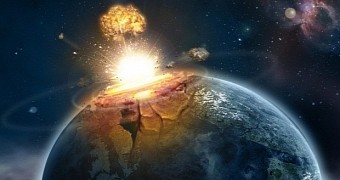In a new report in the journal Tectonophysics, researchers argue that the absolute worst meteorite impacts our planet has until now been through and survived happened in Australia, hundreds of millions of years back.
Since the collisions took place this far back in Earth's history, the craters that they created are no longer visible. Nature eroded them and eventually did away with them altogether quite a while back.
Still, there is one thing that is yet to disappear and that scientists found while completing a geothermal research project: the impact zone associated with the ancient meteorite impacts.
Earth's entrails can reveal its history
This so-called impact zone, described as a collection of scars that the lower layers of our planet's crust ended up sporting after Earth's surface got hit by mammoth meteorites, measures about 400 kilometers (250 miles) across.
The scars that comprise the impact zone are basically rocks turned to glass by the temperature and the pressure of the crashes. The collisions appear to have also created deformations in Earth's crust.
“There are two huge deep domes in the crust, formed by the Earth’s crust rebounding after the huge impacts, and bringing up rock from the mantle below,” said researcher Andrew Glikson.
Based on its size, specialists estimate that the newly discovered impact zone in Australia formed when two space rocks, each measuring about 10 kilometers (over 6 miles) in diameter, crashed into Earth.
Since these impacts appear to have occurred simultaneously, researchers argue that the space rocks were the halves of a much larger meteorite that got torn in two just before reaching our planet's surface.
“It would have been curtains for many life species on the planet at the time,” geophysicist Andrew Glikson with the Australian National University commented on the discovery of this freakishly big impact zone.
It's unclear when the impacts happened
The Australian National University team did their best to determine when the meteorite strikes that birthed the scars lying under Australia happened. Still, they haven't quite succeeded, not yet anyways.
What they do know is that the rocks surrounding this impact zone have been around for about 300 to 600 million years. Whether the crashes occurred closer to 300 or to 600 million years back remains a mystery.
Specialists say that following such collisions, ash should have been scattered all around the globe. These day, this debris should be easy to recover from ancient sediment deposits.
Hence, the Australian National University geophysicists expect that, when they finally find some of this ash, they will be able to tell when the impacts occurred based on the age of the sediment deposits that yielded the debris.

 14 DAY TRIAL //
14 DAY TRIAL //